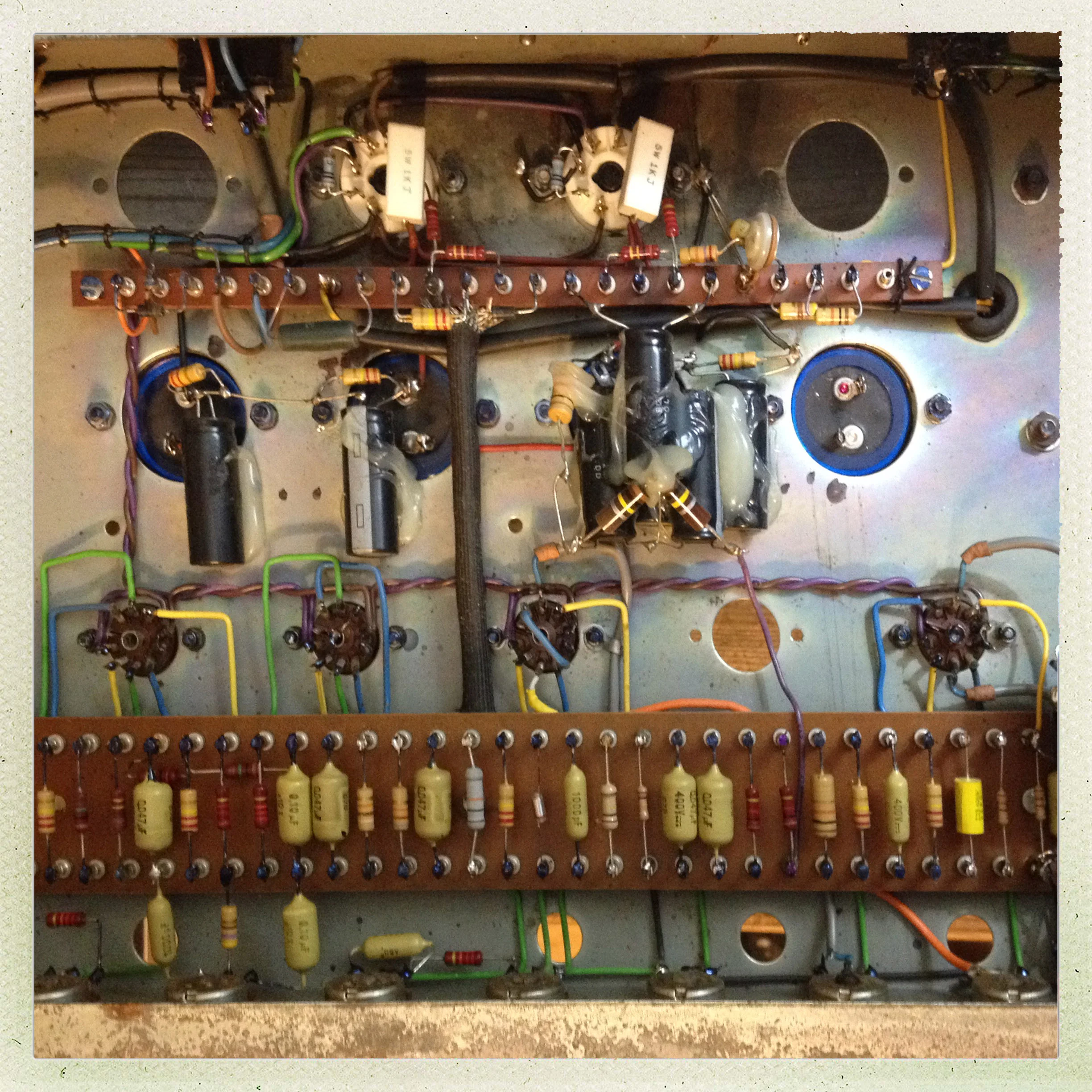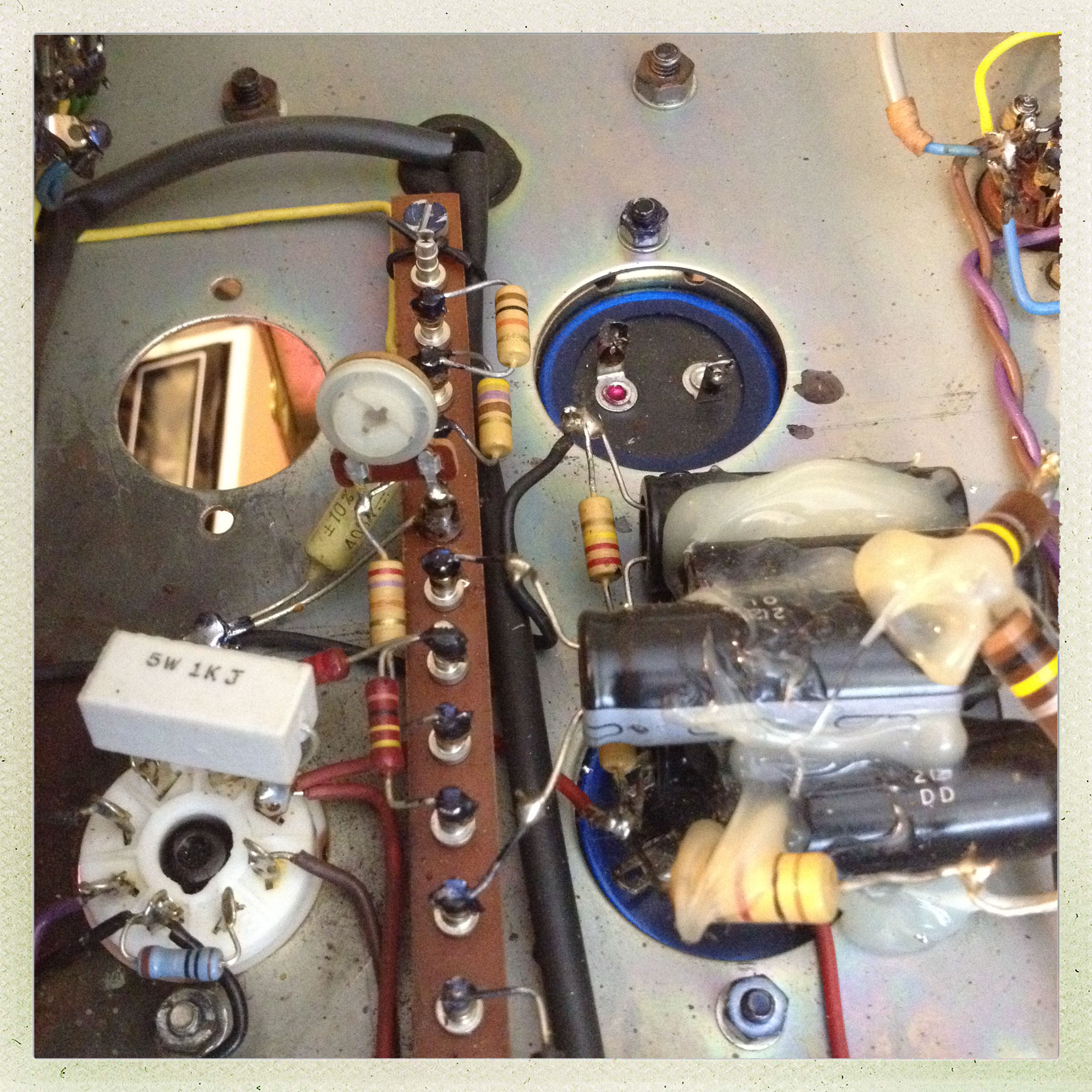Not sure what happened this week, but I've become the half-way house for wayward effect pedals. These guys have seen the road, for sure, but it's not like they were on fire or submerged in sea water. A bad switch here, a DC jack there, and they all work like new. I could build a whole pedalboard out of these discarded misfits. Or (hint, hint) you could! Here's the link where you spend the money!
MXR Distortion 2 - For That New Found Old Sound
A super cool MXR Distortion II from way back when. When what? When pedals were held together with 8 big old screws and had their own 120v cables, that's when. This one had sat dormant for a while. The transformer's connection to ground had come loose and the two diodes in the power supply had died. Surprisingly, the main filter cap was still a-okay. Once resurrected, we were treated to a flavor of grit and drive that we'd forgotten about. Not quite a Muff. Not really a Rat. And not a Tube Screamer either. These have a unique sound that's all their own. The Resonance knob should really be relabeled "meat" or "gravy" or maybe just some sort of grunting sound with quotes around it. Turning it up slathers on a thick layer of beefy bottom end that makes me wonder how it would sound on bass.
More Fun From EHX - Nano Muff and Memory Boy
Two fun repairs on some gear from Electro-Harmonix. The Nano Muff sounded great when engaged, but wouldn't pass clean signal at all. It's usually the other way around, right? A quick re-solder to the switch and a new ribbon connector got things sorted out right away. Mmmmm...fuzzy!
The Memory Boy was a little more tricky. There are seven small trim pots inside that fine tune the various controls and set the bias for the four BBD chips. There are pages upon pages in the EHX forums that specifically tell you NOT TO MESS WITH THE TRIM POTS.... EVER! Well, the previous owner did exactly that. The only solution offered by EHX is to mail your pedal back to the factory so they can recalibrate it using their secret recipe. I figured that in the time it would take to ship the pedal I could just figure it out. How hard could it be? The answer is: hard. Or at least not fun. It took a few hours with the oscilloscope to figure out what the plan was, but now it's all back to normal. And I learned something new!
Both of these will be for sale on my Reverb store shorty if you have a hankering for some fuzzed out delay.
Russian Big Muff - Another Day, Another Muff
I purchased this Russian Big Muff knowing that it was a basket case, but I've fixed so many of these at this point that I can do a Google image search for one without the unintended avalanche of pornography one tends to get (this is a lie, I can't, and you shouldn't try.) Someone decided to paint the sides of the case bright aqua with brushed on acrylic paint. After huffing only a small amount of paint thinner (this is another lie, I'm out of paint thinner, do you have any?) the original black case revealed itself. On the inside, someone attempted to mod the pedal for true-bypass, but had missed a few steps. I completed the bypass mod and the pedal fired up with all the gritty, fuzzy goodness you'd expect. I typically will drill through the case and add a 9volt socket to these, but the board in this one was pristine and unmolested so I decided to leave well enough alone. For all of the silliness it's survived I'd say that this is the best looking and sounding Muff I've worked on. Want proof? Go to my Reverb store and buy it!
1964 Fender VibroVerb - Pre CBS goodness.
I get to see a ton of cool gear, but this one is pretty special. A real-deal 1964 pre-CBS Fender VibroVerb with the original speaker and tubes. Sadly the power tubes and rectifier had to go, but the majority of the preamp tubes still sounded and functioned great. All of the electrolytics were leaking and corroded, but once replaced the amp fired up and didn't disappoint. A few minor tweaks to the vibrato, a new set of kick-back legs, a really deep cleaning, and this old boy was ready to rock n roll again. The best part was finding the vintage Vote for "Bubba" reelection pencil hiding under the reverb tank. I'm not sure if this was Bubba's amp, but who am I to question a man that can rock a tan suit like he did?
Vox Pacemaker - Solid State Surprise
This little Vox Pacemaker changed everything I ever thought about solid state amps. Warm, smooth, and jazzy with a deep tremolo the tone was a complete 180 from what I was expecting. I tend to forget that once upon a time "Solid State" meant "State of the Art." I replaced the taped in (not grounded!) AC cable, because no amp is worth dieing for no matter how good it sounds. The input signal came to a dead end at the treble pot and I think you can tell from the photo the reason why. There's your problem right there! What started as a gamble on a cheap pawn shop find is now someone's main gigging amp.
GK200MV - Like Falling Off A Bike
Over the years I've found that the people I trust the least are the ones that claim to be the best in their fields. The experts. The professionals. The ones that know it all and have seen everything.
There's always a chance to learn new tricks, so I'm going to post something you probably won't see many repair shops show off. I'm going to show you a mistake. This GK200MV came in for a simple fuse holder replacement. The amp had been around the block and the old one had snapped off. Simple. A slam dunk repair! While I was inside I noticed that the power transformer and a few components on the top side of the board were not original. The owner mentioned that he had some work done in the past. No big deal. The work was neatly done and looked legit.
A few weeks later, the amp came back to me with a blown fuse. When powered up the transformer hummed so loud it shook the amp. I disassembled the PCB and found that the underside was covered in a patchwork of previous repairs, most likely two or three layers of work done over a span of years. The rectifier was dead. The output transistors were dead, and none of them were original. The board was physically burned in places. Components were soldered to the underside, and jumpers ran across lifted and missing solder pads. There were spots where corrosion was slowly lifting the circuit away from the board itself. Had I seen any of this the first time I would have declined the repair. With enough money and time anything is fixable. But in this case my opinion was that this was an amp best left to die. It might make sound again, but nothing was going to make it reliable. So what did I learn? Look closer, dig deeper. Don't take anything for granted, and make sure that even your mistakes are valuable.
Orange Rockerverb 50 - All the Verb!
I usually have a hard time finding nice things to say about modern amps, but Orange seems to be the exception. They were designed to be fixable, which is more important than it sounds. All of the components are easily accessible, and they have a sort of built in roll cage that protects the important bits when it's out of its cabinet. This one needed a re-tube and the low voltage rectifier rebuilt. The clean and dirty channels sounded just like I thought they would, but I was surprised by the absolutely cavernous reverb. Hear it for yourself at The Boiler Room right here in Seattle.
HiWatt DR504 - Maximum R n' B
This 1979 HiWatt DR504 was actually a lot of fun. There were some halfway thought out mods done to the preamp to try to get it back to earlier 70s specs, but the real party was in the main power filter caps. The originals had been left in and some sketchy, undersized caps that had been salvaged from some piece of mystery gear had been soldered in as replacements. The whole mess was held in with a big pile of hot glue. I exorcised all of the evil caps and replaced them with brand new JJs. The sound from these is as unique as the hype says it is. Big open chords soar and jangle in a way that make you want to windmill your Les Paul until your fingers bleed. Go check out the Riffbrokers to see this glorious beast in it's natural rock and roll habitat.
Engl Straight 100 - Ich bin ein schlecht durchdachter Gitarrenverstarker
Here's one you don't see every day. An Engl Straight 100 from Germany... with a schematic from Germany.... in German. The power and standby switches had both worn out and needed replacing. Both are conveniently tucked under the power supply board, so you have to remove the whole board to get at them. I really wanted to salvage the unique original switches but ended up replacing them with modern parts (sorry bakelite!) After a good cleaning and some fresh power tubes we were on our way. The front panel offered a nearly endless variety of tones. From sparkling cleans to metal crunch and everything in between. An EQ bypass switch on the lead channel provides a unique wide open tube tone. A weird amp for sure, but one that I'm glad I got to experience.
































